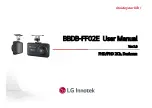
4-2
4.1. LUBRICATION INSTRUCTIONS
No lubrication is required.
4.2. TROUBLESHOOTING
PROCEDURES
4.2.1. TROUBLESHOOTING
Table 4.1. lists common malfunctions that you may find with your
equipment. Perform the tests, inspections and corrective actions in
the order they appear in the table.
This table cannot list all the malfunctions that may occur, all the
tests and inspections needed to find the fault, or all the corrective
actions needed to correct the fault. If the equipment malfunction
is not listed or actions listed do not correct the fault, notify your
maintainer.
TABLE 4.1. OPERATOR’S TROUBLESHOOTING.
MALFUNC-
TION
TEST OR INSPECTION
CORRECTIVE ACTION
1. Monocular
fails to acti-
vate.
Visual.
Check for defective, missing or
improperly installed battery.
Turn power switch to OFF po-
sition and then ON.
Replace battery or install
correctly.
2. Poor image
quality.
Check objective lens or eye-
piece lens focus.
Check for fogging or dirt on ob-
jective lens or eyepiece lens.
Re Calibrate/NUC. Refocus.
Clean lens surface per
paragraph 3.2.
3. Light vis-
ible around
eyecup.
Check eye relief distance.
Check eyecup for resiliency.
Readjust for proper eye relief
distance.
If eyecup is defective, refer to
higher level of maintenance.
4. Diopter
adjustment
cannot be
made.
Check to see if the diopter ad-
justment is bent or broken.
If damaged, refer to higher
level of maintenance.
Summary of Contents for OTS-X Series
Page 9: ...1 1 CHAPTER 1 INTRODUCTION ...
Page 20: ...1 12 ...
Page 21: ...2 1 CHAPTER 2 ASSEMBLY AND PREPARATION ...
Page 24: ...2 4 ...
Page 25: ...3 1 CHAPTER 3 OPERATION ...



































